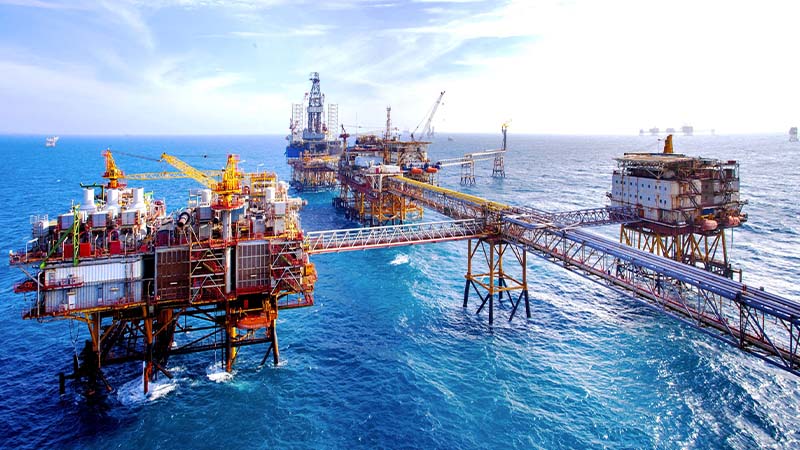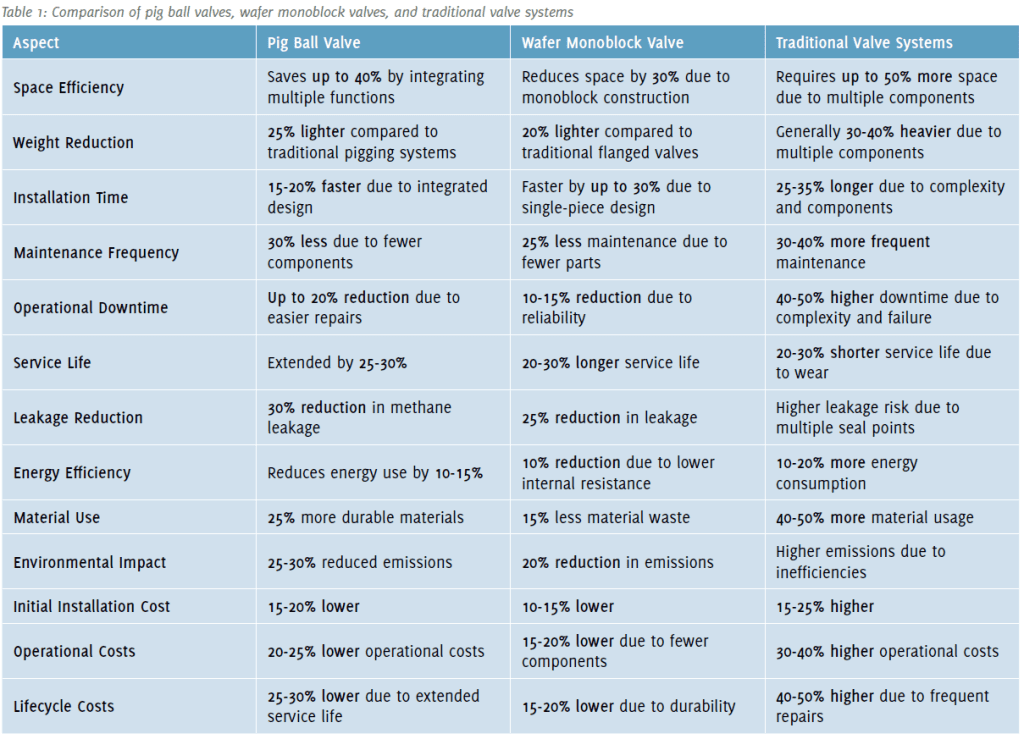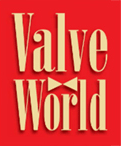This article discusses why offshore platforms need modern valve technologies, highlighting how they solve challenges posed by traditional valve systems while providing benefits in terms of cost, sustainability and performance.
By Zahra Farrokhi, Batu Valve Türkiye
Offshore platforms are essential to the energy sector, facilitating oil and gas extraction and transportation. However, as the need for cleaner energy and improved efficiency grows, the limitations of traditional valve systems have become evident. These conventional systems often take up valuable space and add unnecessary weight to offshore structures. Modern valve technologies, such as pig ball valves and wafer monoblock valves, offer considerable improvements in optimising space, reducing weight and enhancing operational efficiency.

1. Challenges of traditional valve systems in offshore platforms
While traditional valve systems have proven reliable, they present several challenges when used on offshore platforms.
Weight and space constraints
Traditional valve systems are bulky, comprising of multiple components such as pig launchers, receivers and piping. These systems consume significant space on offshore platforms, contributing to the overall weight, which can affect structural integrity and increase maintenance costs. As offshore operations demand more efficient platform designs, reducing the space required for valve systems has become crucial (Smith & Jones, 2023) (Garcia & Martinez, 2024).
Maintenance and durability issues
Older valve systems are prone to wear and corrosion due to the harsh offshore environment, leading to frequent maintenance and system downtime. This results in costly repairs and reduced operational efficiency (Evans & Brown, 2023). Furthermore, constant repairs and replacements contribute to the environmental footprint of offshore operations (Garcia & Martinez, 2024).
2. Defining pig ball valves and wafer monoblock valves
Understanding the innovations offered by pig ball valves and wafer monoblock valves is essential to appreciating their benefits in offshore operations.
Pig ball valves
Pig ball valves are used in pigging operations—essential for cleaning and inspecting pipelines without removing the valve. These valves streamline the process by combining multiple components into a single unit, optimising space and reducing weight (Harris & White, 2023).

Wafer monoblock valves
Wafer monoblock valves feature a single-piece design that reduces the number of components, lowering both the weight and space requirements. This type of valve fits seamlessly between two flanges, simplifying installation and ensuring enhanced reliability due to fewer potential leak points (Zhang & Li, 2024).

3. Why offshore platforms need pig ball and wafer monoblock ball valves
As offshore operations evolve, valve technologies that offer improved efficiency, reduced weight and minimal space usage are increasingly essential. Pig ball valves and wafer monoblock valves are designed to meet these needs, offering numerous advantages over traditional valve systems.
Space and weight optimisation
Traditional valve systems require multiple components, such as launchers and receivers, consuming significant space and increasing the platform’s weight. Pig ball valves integrate the functions of these components into a single unit, reducing both space and weight (Smith & Jones, 2023). Similarly, wafer monoblock valves are made from a single piece of material, resulting in smaller, lighter valves, critical in space-constrained offshore environments (Zhang & Li, 2024; Garcia & Martinez, 2024; Zhang & Li, 2024).
4. Reduced weight and space usage
Both pig ball valves and wafer monoblock valves stand out due to their significant reductions in weight and space usage, which are vital in offshore applications.
Pig ball valves:
- Compact design: the integrated design eliminates the need for separate pig launchers, receivers and piping, reducing both space and weight on offshore platforms (Harris & White, 2023).
- Space optimisation: by reducing the number of components, pig ball valves occupy less space, which is crucial for offshore operations (Garcia & Martinez, 2024).
Wafer monoblock valves:
- Monoblock construction: the single-piece design of wafer monoblock valves reduces the number of components, thus reducing both space and weight requirements (Zhang & Li, 2024).
- Simplified integration: the compact design allows for easier integration into existing systems, which optimises space and reduces installation time (Chen & Zhao, 2024).

5. Lower costs and cost-effectiveness
Both valve types offer significant cost-saving advantages over traditional valve systems.
Pig ball valves:
- Lower initial and operational costs: the reduced number of components simplifies installation and lowers upfront costs. Maintenance savings are also notable, with pig ball valves requiring less maintenance than traditional systems (Harris & White, 2023).
- Statistical data: pig ball valves reduce installation costs by 15% and operational costs by 20% over their lifecycle (Garcia & Martinez, 2024).
Wafer monoblock valves:
- Material savings: wafer monoblock valves use less material due to their monoblock design, lowering manufacturing and material costs (Zhang & Li, 2024).
- Lower lifecycle costs: despite a higher initial cost, the durability of wafer monoblock valves and their reduced maintenance needs lead to lower lifecycle costs (Chen & Zhao, 2024).
6. Simplified installation

Both pig ball valves and wafer monoblock valves simplify the installation process, resulting in significant savings in time and labour.
Pig ball valves:
- Streamlined design: the integrated design reduces installation complexity, saving time and costs (Harris & White, 2023).
- Faster setup: with fewer components to install, the setup is quicker, allowing offshore platforms to resume operations faster (Evans & Brown, 2023).
Wafer monoblock valves:
- Ease of deployment: the single-piece design of wafer monoblock valves eliminates the need for multiple connections, leading to faster and simpler installation (Zhang & Li, 2024).
- Seamless integration: their compact nature also simplifies integration into existing systems, speeding up the overall installation process (Chen & Zhao, 2024).
7. Improved efficiency
Both pig ball valves and wafer monoblock valves contribute to improved efficiency in offshore operations by optimising pipeline maintenance and enhancing flow control.
Pig ball valves:
- Enhanced pipeline efficiency: the streamlined pigging process with pig ball valves reduces downtime and enhances pipeline maintenance (Chen & Zhao, 2024).
- Improved flow control: pig ball valves provide better flow control, ensuring smoother pipeline operations with minimal disruptions (Evans & Brown, 2023).
Wafer monoblock valves:
- Optimised flow: the excellent sealing and flow control capabilities of wafer monoblock valves minimise resistance and optimise flow efficiency (Zhang & Li, 2024).
- Increased reliability: their robust design enhances reliability, ensuring uninterrupted operations on offshore platforms (Chen & Zhao, 2024).

8. Sustainability and environmental concerns
Both pig ball valves and wafer monoblock valves provide substantial environmental benefits, contributing to sustainable offshore operations.
Pig ball valves:
- Leakage reduction: the advanced sealing technology reduces the potential for leaks, crucial for minimising emissions in offshore environments (Jansen & Muller, 2023).
- Energy efficiency: the optimised flow provided by pig ball valves helps reduce friction, lowering energy consumption (Smith & Jones, 2023).
Wafer monoblock valves:
- Material sustainability: the use of durable materials in wafer monoblock valves extends their lifespan, reducing the need for frequent replacements and minimising waste (Zhang & Li, 2024).
- Reduced carbon footprint: the reduction in material waste and maintenance requirements helps wafer monoblock valves contribute to a lower carbon footprint (Chen & Zhao, 2024).
Conclusion
The integration of pig ball valves and wafer monoblock valves into offshore operations provides a clear path toward optimising space, reducing weight and improving operational efficiency. These modern valve technologies address the challenges posed by traditional systems and offer significant advantages in terms of cost, installation, sustainability and reliability. As offshore platforms continue to evolve, the adoption of these advanced valve solutions will play a pivotal role in meeting the growing demands of the energy sector while minimising environmental impact.
References available on request
About Batu Valve Türkiye
Batu Valve Türkiye specialises in advanced valve solutions for offshore platforms, offering pig ball and wafer monoblock valves that optimise space, reduce weight and enhance operational efficiency. Their innovative designs provide reliable, durable and cost-effective solutions for high-pressure offshore applications, ensuring sustainable operations and minimal environmental impact. Explore more at www.batuvalve.com.
About this Technical Story
This Technical Story is an article from our Valve World Magazine, February 2025 issue. To read other featured stories and many more articles, subscribe to our print magazine. Available in both print and digital formats. DIGITAL MAGAZINE SUBSCRIPTIONS ARE NOW FREE.
“Every week we share a new Technical Story with our Valve World community. Join us and let’s share your Featured Story on Valve World online and in print.”

